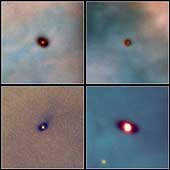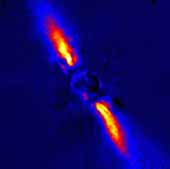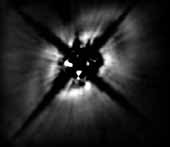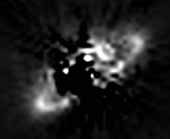
— Thomas Browne
|
Origins Table of Contents |
|
More Information |
 |
| Protoplanetary disks edge on. [more] |
 |
 |
 |
| Thin disk around Beta Pictoris. [more] | HD 141569: Gap in stellar dust disk. [more] | HR 4796A: Dust ring around star. [more] |
| These three images show dust rings around a newly formed stars. Beta Pictoris' disk is slightly warped possibly due to the gravitational pull of a planet. The other two images also show gaps, bright and dark areas similar to Saturn's rings. | ||
Some planetesimals in the outer solar system became large enough to accrete gas forming the giant planets Juipter, Saturn, Uranus, and Neptune. Because of the higher temperatures in the inner solar system, accretion of ice and gas was inhibited so the planetesimals grew into what is known as the rocky terrestrial planets. Planetary growth slowed down significantly once a gap was cleared within its orbit. But even today planets continue to grow by small amounts as they sweep up micrometeor dust particles or are impacted every few million years by larger asteroids or comets such as the dramatic impact of comet Shoemaker-Levy with Jupiter.
Planetesimals that became modest in size but did not merge to form larger bodies became asteroids and comets. The asteroid belt may be result of fragmentation of planetisimals that were prevented from growing larger by the close proximity of Jupiter's gravitational pull. Other planetesimals were tossed about into random orbits from gravitational interaction with the larger planets. The Oort Cloud was formed early in the history of the solar system through gravitational interaction of planetisimals with Uranus and Neptune. (Close encounters with Saturn and Jupiter would have ejected the objects out of the solar system.) These planetisimals were thrown outwards close to the Solar System escape velocity. The Oort cloud consists of some 1,000,000,000,000 long-period comets that extends out to tens of thousands of AU, half way to our closest stellar neighbors. Comets found within Kuiper Belt may be early remnants of the Sun's protoplanetary disk. Additional debris left over from the earliest phases of solar system formation includes small grains of sand and small Meteorids.